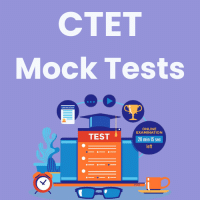CTET & State TET Exam > CTET & State TET Questions > Hands-on activities and projects form an inte...
Start Learning for Free
Hands-on activities and projects form an integral part of learning of science. These learning experiences primarily aim at:
- a)maintaining disciplines in the laboratory
- b)providing opportunity to students for extended learning
- c)assessing the students on practical skills
- d)keeping the students engaged all the time
Correct answer is option 'B'. Can you explain this answer?
Verified Answer
Hands-on activities and projects form an integral part of learning of ...
Hands-on activities and projects in science primarily aim at providing opportunities to students for extended learning.
View all questions of this test
Most Upvoted Answer
Hands-on activities and projects form an integral part of learning of ...
Providing opportunity to students for extended learning:
Hands-on activities and projects in science allow students to apply theoretical knowledge to real-life situations. This provides a deeper understanding of concepts and principles, allowing for extended learning beyond what is taught in textbooks.
Engaging students in active learning:
By engaging in hands-on activities and projects, students are actively involved in the learning process. This not only keeps them engaged and interested in the subject matter but also helps improve retention and understanding of the material.
Developing critical thinking skills:
Hands-on activities and projects require students to think critically, problem-solve, and make decisions based on evidence. This helps develop important skills that are essential for success in science and in other areas of life.
Fostering creativity and innovation:
Through hands-on activities and projects, students are encouraged to think creatively and come up with unique solutions to problems. This fosters innovation and allows students to explore new ideas and concepts.
Building teamwork and collaboration:
Many hands-on activities and projects in science require students to work together in groups. This helps develop teamwork and collaboration skills, which are important for success in both academic and professional settings.
In conclusion, hands-on activities and projects in science play a crucial role in providing students with extended learning opportunities, keeping them engaged, developing critical thinking skills, fostering creativity and innovation, and building teamwork and collaboration skills.
Hands-on activities and projects in science allow students to apply theoretical knowledge to real-life situations. This provides a deeper understanding of concepts and principles, allowing for extended learning beyond what is taught in textbooks.
Engaging students in active learning:
By engaging in hands-on activities and projects, students are actively involved in the learning process. This not only keeps them engaged and interested in the subject matter but also helps improve retention and understanding of the material.
Developing critical thinking skills:
Hands-on activities and projects require students to think critically, problem-solve, and make decisions based on evidence. This helps develop important skills that are essential for success in science and in other areas of life.
Fostering creativity and innovation:
Through hands-on activities and projects, students are encouraged to think creatively and come up with unique solutions to problems. This fosters innovation and allows students to explore new ideas and concepts.
Building teamwork and collaboration:
Many hands-on activities and projects in science require students to work together in groups. This helps develop teamwork and collaboration skills, which are important for success in both academic and professional settings.
In conclusion, hands-on activities and projects in science play a crucial role in providing students with extended learning opportunities, keeping them engaged, developing critical thinking skills, fostering creativity and innovation, and building teamwork and collaboration skills.

|
Explore Courses for CTET & State TET exam
|

|
Question Description
Hands-on activities and projects form an integral part of learning of science. These learning experiences primarily aim at:a)maintaining disciplines in the laboratoryb)providing opportunity to students for extended learningc)assessing the students on practical skillsd)keeping the students engaged all the timeCorrect answer is option 'B'. Can you explain this answer? for CTET & State TET 2025 is part of CTET & State TET preparation. The Question and answers have been prepared according to the CTET & State TET exam syllabus. Information about Hands-on activities and projects form an integral part of learning of science. These learning experiences primarily aim at:a)maintaining disciplines in the laboratoryb)providing opportunity to students for extended learningc)assessing the students on practical skillsd)keeping the students engaged all the timeCorrect answer is option 'B'. Can you explain this answer? covers all topics & solutions for CTET & State TET 2025 Exam. Find important definitions, questions, meanings, examples, exercises and tests below for Hands-on activities and projects form an integral part of learning of science. These learning experiences primarily aim at:a)maintaining disciplines in the laboratoryb)providing opportunity to students for extended learningc)assessing the students on practical skillsd)keeping the students engaged all the timeCorrect answer is option 'B'. Can you explain this answer?.
Hands-on activities and projects form an integral part of learning of science. These learning experiences primarily aim at:a)maintaining disciplines in the laboratoryb)providing opportunity to students for extended learningc)assessing the students on practical skillsd)keeping the students engaged all the timeCorrect answer is option 'B'. Can you explain this answer? for CTET & State TET 2025 is part of CTET & State TET preparation. The Question and answers have been prepared according to the CTET & State TET exam syllabus. Information about Hands-on activities and projects form an integral part of learning of science. These learning experiences primarily aim at:a)maintaining disciplines in the laboratoryb)providing opportunity to students for extended learningc)assessing the students on practical skillsd)keeping the students engaged all the timeCorrect answer is option 'B'. Can you explain this answer? covers all topics & solutions for CTET & State TET 2025 Exam. Find important definitions, questions, meanings, examples, exercises and tests below for Hands-on activities and projects form an integral part of learning of science. These learning experiences primarily aim at:a)maintaining disciplines in the laboratoryb)providing opportunity to students for extended learningc)assessing the students on practical skillsd)keeping the students engaged all the timeCorrect answer is option 'B'. Can you explain this answer?.
Solutions for Hands-on activities and projects form an integral part of learning of science. These learning experiences primarily aim at:a)maintaining disciplines in the laboratoryb)providing opportunity to students for extended learningc)assessing the students on practical skillsd)keeping the students engaged all the timeCorrect answer is option 'B'. Can you explain this answer? in English & in Hindi are available as part of our courses for CTET & State TET.
Download more important topics, notes, lectures and mock test series for CTET & State TET Exam by signing up for free.
Here you can find the meaning of Hands-on activities and projects form an integral part of learning of science. These learning experiences primarily aim at:a)maintaining disciplines in the laboratoryb)providing opportunity to students for extended learningc)assessing the students on practical skillsd)keeping the students engaged all the timeCorrect answer is option 'B'. Can you explain this answer? defined & explained in the simplest way possible. Besides giving the explanation of
Hands-on activities and projects form an integral part of learning of science. These learning experiences primarily aim at:a)maintaining disciplines in the laboratoryb)providing opportunity to students for extended learningc)assessing the students on practical skillsd)keeping the students engaged all the timeCorrect answer is option 'B'. Can you explain this answer?, a detailed solution for Hands-on activities and projects form an integral part of learning of science. These learning experiences primarily aim at:a)maintaining disciplines in the laboratoryb)providing opportunity to students for extended learningc)assessing the students on practical skillsd)keeping the students engaged all the timeCorrect answer is option 'B'. Can you explain this answer? has been provided alongside types of Hands-on activities and projects form an integral part of learning of science. These learning experiences primarily aim at:a)maintaining disciplines in the laboratoryb)providing opportunity to students for extended learningc)assessing the students on practical skillsd)keeping the students engaged all the timeCorrect answer is option 'B'. Can you explain this answer? theory, EduRev gives you an
ample number of questions to practice Hands-on activities and projects form an integral part of learning of science. These learning experiences primarily aim at:a)maintaining disciplines in the laboratoryb)providing opportunity to students for extended learningc)assessing the students on practical skillsd)keeping the students engaged all the timeCorrect answer is option 'B'. Can you explain this answer? tests, examples and also practice CTET & State TET tests.

|
Explore Courses for CTET & State TET exam
|

|
Signup for Free!
Signup to see your scores go up within 7 days! Learn & Practice with 1000+ FREE Notes, Videos & Tests.


















